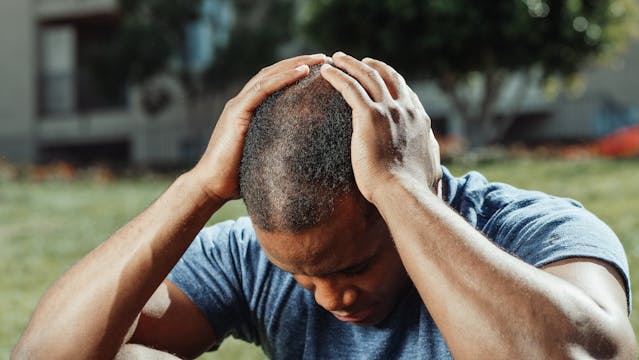Hair loss is a common concern for many men, often affecting self-esteem and confidence. Whether it’s due to genetics, lifestyle, or health issues, managing hair loss can be challenging. However, with the right approach and understanding, it’s possible to navigate this journey with confidence. Here are some practical tips for men dealing with hair loss.
Understand the Causes of Hair Loss
The first step in dealing with hair loss is understanding its root cause. Common causes include:
- Genetics: Male pattern baldness (androgenetic alopecia) is the most common cause of hair loss in men, often influenced by family history.
- Hormonal Changes: Hormonal imbalances, such as an excess of dihydrotestosterone (DHT), can lead to hair thinning.
- Medical Conditions: Conditions like alopecia areata, thyroid disorders, or scalp infections can cause hair loss.
- Lifestyle Factors: Stress, poor diet, and lack of sleep can contribute to hair shedding.
Identifying the cause can help determine the most effective treatment or management strategy.
Adopt a Healthy Lifestyle
A healthy lifestyle can positively impact hair health. Consider the following changes:
- Balanced Diet: Ensure your diet is rich in vitamins and minerals that promote hair growth, such as biotin, zinc, iron, and vitamin D.
- Regular Exercise: Physical activity improves blood circulation, which can help deliver nutrients to hair follicles.
- Stress Management: Practice stress-relieving activities like yoga, meditation, or hobbies to reduce the impact of stress on hair loss.
- Adequate Sleep: Aim for 7-8 hours of quality sleep each night to allow your body to repair and rejuvenate, including your hair follicles.
Explore Treatment Options
Several treatments are available for managing hair loss. Here are some popular options:
- Topical Treatments: Minoxidil (Rogaine) is a widely used over-the-counter treatment that can slow hair loss and promote new hair growth.
- Medications: Finasteride (Propecia) is a prescription medication that reduces DHT levels, which can help slow hair loss and, in some cases, regrow hair.
- Hair Transplant Surgery: For those with significant hair loss, hair transplant surgery offers a more permanent solution by relocating hair follicles from one part of the scalp to another.
- Low-Level Laser Therapy (LLLT): This non-invasive treatment uses light therapy to stimulate hair follicles and promote hair growth.
- Scalp Micropigmentation (SMP): For men experiencing severe hair loss or thinning, a non-invasive scalp micropigmentation offers a solution to restore the appearance of a fuller head of hair by tattooing natural-looking dots on the scalp.
Consult a dermatologist or trichologist to determine which treatment is most suitable for your condition.
Opt for Suitable Hairstyles
Choosing the right hairstyle can make a significant difference in how hair loss is perceived. Consider these styling tips:
- Short Haircuts: Shorter styles can make thinning hair less noticeable and create a more balanced look.
- Buzz Cut or Shaved Head: Embracing a buzz cut or shaving your head can be a bold and confident choice that many men find liberating.
- Textured Styles: Adding texture can give the illusion of thicker hair. Discuss options with your barber or hairstylist.
Use Hair Care Products Wisely
The right hair care products can help maintain healthy hair and scalp. Look for:
- Gentle Shampoos: Choose sulfate-free shampoos that won’t strip natural oils from your scalp.
- Conditioners: Use conditioners with ingredients like keratin or biotin to strengthen hair and improve its appearance.
- Styling Products: Avoid heavy gels or waxes that can weigh down hair and make thinning more apparent. Opt for lightweight mousses or sprays that add volume.
Consider Scalp Care
A healthy scalp is crucial for healthy hair. Incorporate these practices into your routine:
- Regular Scalp Massage: Massaging your scalp can improve blood flow and stimulate hair follicles.
- Exfoliation: Use a scalp scrub or exfoliating shampoo to remove dead skin cells and promote a clean scalp environment.
- Moisturizing: Keep your scalp hydrated to prevent dryness and irritation, which can contribute to hair loss.
Boost Confidence with Accessories
Accessories can be a great way to enhance your style and confidence. Consider wearing hats, caps, or scarves that complement your look. These can also protect your scalp from sun damage, which is crucial if you have thinning hair or a shaved head.
Embrace Acceptance
Finally, it’s essential to embrace and accept your appearance. Hair loss does not define your identity or worth. Many men find confidence in embracing their new look and focusing on other aspects of their appearance or personality. Remember, confidence is the most attractive trait.
Seek Support
Talking to others who are experiencing similar challenges can be helpful. Join online forums, support groups, or communities where you can share experiences, tips, and encouragement.
Conclusion
Dealing with hair loss can be a journey, but with the right mindset and strategies, it’s possible to manage and even embrace the changes. Focus on maintaining a healthy lifestyle, exploring treatment options, and finding styles that make you feel confident. Remember, hair is just one part of who you are, and embracing your unique look can lead to greater self-confidence and satisfaction.



